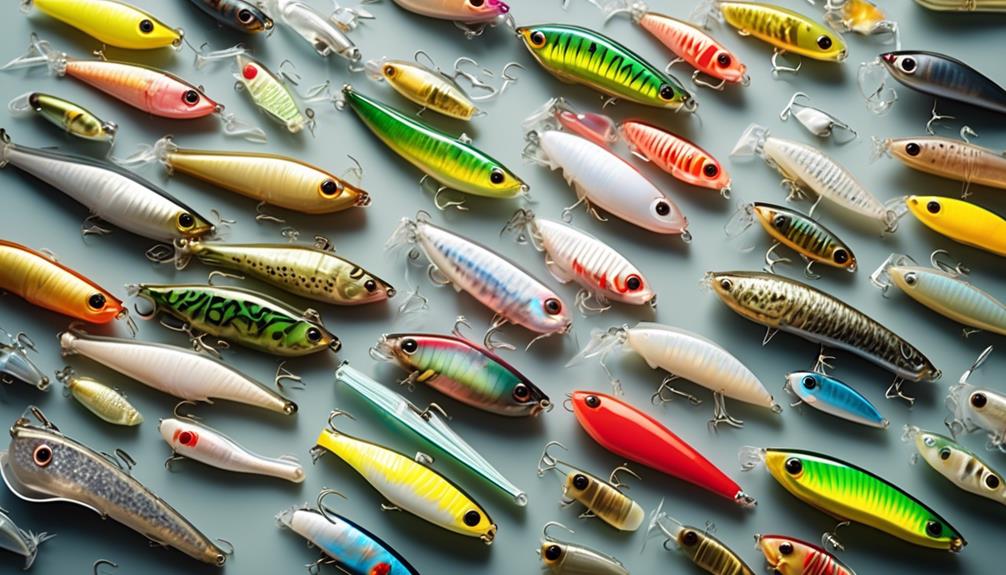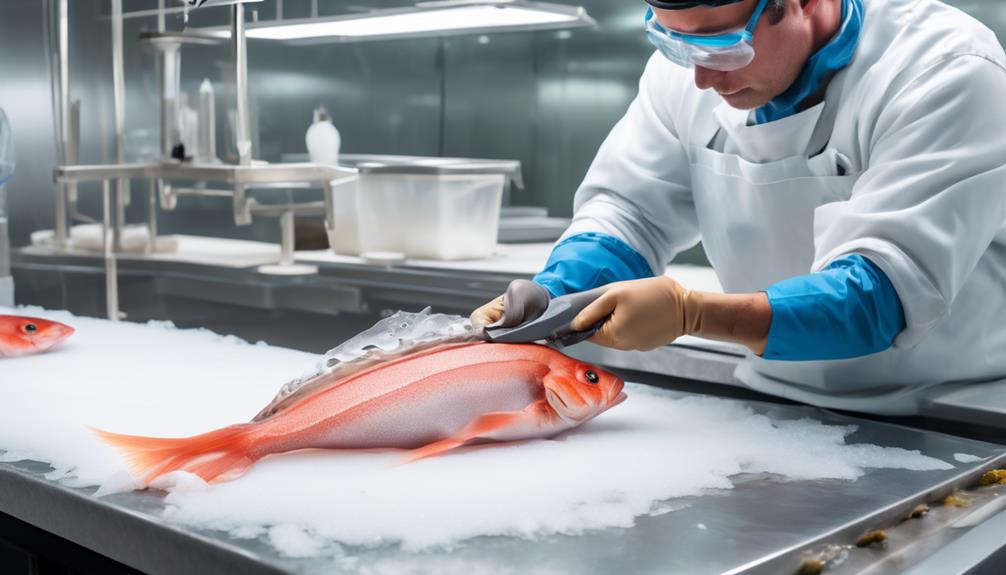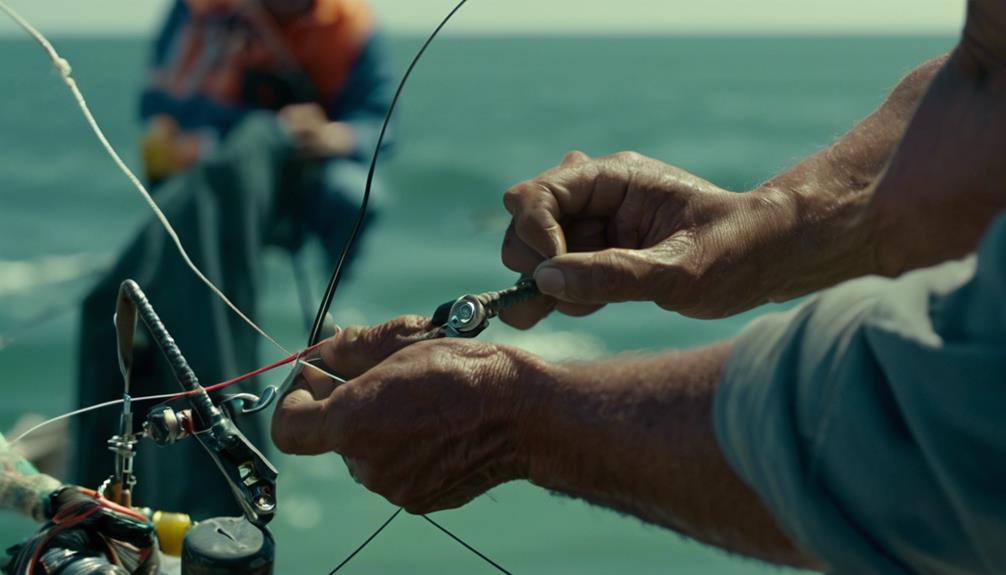You might think that selecting the right saltwater fishing bait is just a matter of personal preference or luck, but there's actually a science behind it that can significantly improve your chances of a successful catch.
Whether you're a seasoned angler or just starting out, knowing the essential tips for choosing the best bait can make all the difference in your fishing experience.
So, let's dive into the key factors to consider when it comes to selecting saltwater fishing bait and how they can elevate your fishing game to the next level.
Understanding the Target Species
To improve your chances of success, understanding the behavior and preferences of the target species is essential when selecting the right bait for saltwater fishing. Saltwater predators have specific feeding habits and preferences, and comprehending these can significantly enhance your fishing experience. Understanding predator behavior is crucial in determining the most effective bait selection techniques.
Different fish species exhibit distinct feeding behaviors. For example, predatory fish like snapper and grouper are more likely to be attracted to live bait, such as shrimp or small fish, due to their natural hunting instincts. On the other hand, some species, like barracuda, are attracted to fast-moving artificial lures that mimic the movements of their prey. By observing and researching the behavior of the target species, you can tailor your bait selection to match their preferences.
Additionally, the habitat of the target species also influences their feeding habits. For instance, if you're fishing in an area with a lot of structure, such as reefs or wrecks, using natural baits like live baitfish or squid can be more effective as they closely resemble the natural food sources found in those areas. Understanding the specific environment where the target species resides can help you choose the most appropriate bait for a successful fishing trip.
Consider the Water Conditions
Considering the water conditions is crucial when selecting the right bait for saltwater fishing. The success of your fishing expedition greatly depends on understanding the water temperature and tidal movement. Here are some important factors to consider:
- Water Temperature:
- Warmer Water: In warmer waters, fish tend to be more active and have higher metabolisms. This means they may be more aggressive towards bait. Consider using live bait or fast-moving lures to entice bites from active fish.
- Cooler Water: In cooler waters, fish are generally more lethargic. They may not be as willing to chase after fast-moving baits. Opt for slower presentations or natural baits that can be fished at varying depths to entice bites from sluggish fish.
- Tidal Movement:
- Incoming Tide: During an incoming tide, baitfish and other prey are often pushed towards the shoreline. Predatory fish will follow, making it an excellent time to fish near structures or in shallower waters using bait that mimics the local forage.
- Outgoing Tide: As the tide moves out, baitfish and other prey are pulled away from the shoreline. Predatory fish may wait in ambush for prey being carried away. Consider using bait that can be cast farther out or near deeper channels to target fish waiting to ambush prey.
Understanding the water temperature and tidal movement allows you to choose the most effective bait for the conditions, increasing your chances of a successful saltwater fishing trip.
Assess the Local Baitfish Population
When assessing the local baitfish population for saltwater fishing, it's essential to observe the types and abundance of baitfish in the area. Start by closely observing the behavior of the baitfish. Look for signs of their feeding habits, such as jumping out of the water or swimming near the surface. These behaviors can give you valuable insight into the types of baitfish present and their availability to predators, including the fish you're targeting.
In addition to behavior, take note of the baitfish availability in the area. Are there large schools of baitfish present, or are they more scattered? Understanding the availability of baitfish can help you determine the best bait to use for your saltwater fishing expedition. If baitfish are abundant, you may opt for artificial lures that mimic their movements. On the other hand, if baitfish are scarce, using live bait may be more effective in attracting the predatory fish.
Matching Bait to Fishing Technique
After observing the behavior and availability of the local baitfish, you can now focus on matching the appropriate bait to your chosen fishing technique for maximum effectiveness. When it comes to bait retrieval, the way you present the bait to the fish is crucial. For example, if you're using live bait and want to mimic wounded prey, a slow and erratic retrieval method would be suitable. On the other hand, for artificial lures, a steady and consistent retrieval might be more effective in attracting certain species.
Here's a breakdown to guide you in matching bait to your fishing technique:
- Bait Retrieval
- For slow and erratic retrieval techniques, consider using injured or weakened live bait to mimic wounded prey.
- For steady and consistent retrieval, artificial lures like spoons or plugs can be effective in attracting fish looking for a steady meal.
- Bait Size
- Match the size of your bait to the size of the local baitfish. Using bait that closely resembles the local baitfish in size can increase your chances of a successful catch.
- Consider the size of the target species. Larger predatory fish may be more attracted to bigger baits, while smaller baits might be more suitable for smaller species or juveniles.
Importance of Bait Presentation
To maximize your chances of attracting fish, it's essential to pay close attention to the presentation of your bait. Bait movement plays a crucial role in enticing saltwater fish. The way your bait moves in the water can make the difference between a successful catch and a fruitless day on the water.
When selecting bait, consider the natural movement of the prey you're imitating and try to mimic it as closely as possible. For example, if you're using live shrimp as bait, ensure that it moves naturally in the water to attract the attention of predatory fish.
Utilizing the right hook size is also vital for bait presentation. A hook that's too large can weigh down the bait and impede its movement, while a hook that's too small may not provide adequate support for the bait. It's crucial to match the hook size to the type and size of bait you're using to ensure it can move freely and naturally in the water.
Additionally, consider the depth at which the fish are most likely to be feeding and adjust your bait presentation accordingly. By paying attention to bait movement and using the appropriate hook size, you can significantly enhance your chances of enticing saltwater fish and making a successful catch.
Evaluating Bait Durability
Considering the conditions of the fishing environment and the predatory nature of saltwater fish, assessing the durability of your bait is crucial for ensuring its effectiveness in attracting and retaining the attention of your target species. When evaluating the durability of saltwater fishing bait, it's important to consider factors such as the strength of the bait against the force of ocean currents and the resilience of the bait when faced with aggressive strikes from larger saltwater species.
Here are some key points to keep in mind when evaluating bait durability:
- Material Strength: The durability of the bait material plays a significant role in its ability to withstand the harsh saltwater environment and the force of ocean currents. Look for baits made from robust materials that can endure prolonged exposure to saltwater without deteriorating.
- Bait Preservation: Proper bait preservation techniques, such as storing bait in airtight containers or using bait preservatives, can significantly enhance the durability of the bait and maintain its freshness for longer periods.
- Bait Storage: Effective bait storage is essential for preserving the durability of the bait. Ensure that the storage containers provide protection against moisture and exposure to direct sunlight, as these factors can compromise the durability of the bait.
Factoring in Seasonal Variations

Incorporate the changing behaviors of saltwater fish into your bait selection process to adapt to seasonal variations and maximize your fishing success. Seasonal variations significantly impact saltwater fishing, so understanding these changes is crucial for successful bait selection. Bait availability, weather, tides, and migration patterns are key factors to consider.
During different seasons, the availability of natural bait varies. In spring and summer, for example, baitfish like mullet and menhaden are more abundant, while in fall and winter, shrimp and crabs become prevalent. Understanding the prevalent natural bait during a season can guide your artificial bait selection. Additionally, weather conditions play a substantial role. For instance, during stormy weather, fish may be less active and prefer different types of bait compared to calm, sunny days. It's essential to adapt your bait choices based on prevailing weather patterns.
Tides also influence fish behavior and feeding patterns. During high tides, predatory fish may move closer to shorelines and marsh areas, seeking prey that moves with the rising water. Therefore, using bait that mimics the local forage can be highly effective. Conversely, during low tides, fish may migrate to deeper waters, requiring different bait presentations to entice strikes. Understanding these tidal patterns is essential for successful bait selection.
Furthermore, seasonal migration patterns of baitfish and predatory species should be taken into account. For example, during the spring, many species migrate from deeper waters to shallower areas for spawning, presenting unique bait opportunities. Similarly, understanding the migration patterns of larger predatory species can help in selecting the most effective bait for targeting specific fish during their peak activity periods. By factoring in seasonal variations, you can tailor your bait selection to match the natural forage and behaviors of saltwater fish, improving your chances of a successful fishing trip.
Exploring Artificial Bait Options
Explore various options for artificial bait by considering the seasonal variations and behaviors of saltwater fish that impact your bait selection process. When it comes to choosing artificial bait for saltwater fishing, it's essential to take into account the specific preferences of the fish species you're targeting, as well as the environmental factors that influence their feeding habits. Here's a breakdown of what you should consider:
- Bait Material Options:
- *Soft Plastics:* These baits are versatile and come in a wide range of shapes and colors, mimicking various prey species. They're effective for a variety of saltwater fish, including snook, redfish, and seatrout.
- *Hard Baits:* These lures are typically made of wood or plastic and are designed to mimic the movement of live bait. Consider using topwater plugs for species like striped bass and bluefish, and diving plugs for species that feed at deeper depths.
- Environmental Impact:
- *Sustainability:* When choosing artificial bait, consider the environmental impact of the materials used. Look for biodegradable options or lures made from recycled materials to minimize your ecological footprint.
- *Single-Use Plastics:* Be mindful of the potential environmental consequences of using single-use plastic lures. Opt for reusable or eco-friendly alternatives to reduce waste and minimize harm to marine life.
As you explore artificial bait options, keep in mind the specific habits and preferences of the saltwater fish you're targeting, while also considering the potential environmental impact of your bait choices. By making informed decisions, you can enhance your fishing experience while minimizing harm to the marine ecosystem.
Frequently Asked Questions
What Are Some Common Mistakes to Avoid When Using Live Bait for Saltwater Fishing?
When using live bait for saltwater fishing, avoid common mistakes such as poor bait presentation, improper bait preservation, and not targeting gamefish effectively. Consider alternative bait options to maximize your chances of a successful catch.
Are There Any Specific Regulations or Restrictions on Using Certain Types of Bait in Different Saltwater Fishing Locations?
When fishing in different saltwater locations, it's crucial to be aware of bait regulations and restrictions. Always check local guidelines for any specific rules. Also, practice bait conservation and proper storage to maintain its effectiveness.
How Can I Properly Store and Preserve My Bait to Ensure It Remains Fresh and Effective for Longer Periods of Time?
To properly store and preserve your bait, keep it in an airtight container in the fridge or freezer. Use bait preservatives like salt or brine to keep it fresh. Replace old bait regularly to maintain its effectiveness.
Are There Any Unique Baiting Techniques or Strategies That Can Be Used for Targeting Specific Saltwater Gamefish Species?
When targeting marlin, try using live bait like skipjack tuna and mackerel. For barracuda, consider trolling with flashy lures to mimic the movement of smaller fish. These techniques and baiting strategies can improve your saltwater gamefish success.
What Are Some Alternative Bait Options for Saltwater Fishing That May Be Less Commonly Known but Still Effective?
When targeting saltwater gamefish, consider using uncommon bait options. Despite being less known, they can be surprisingly effective. Experiment with alternative bait to increase your chances of success and discover new fishing opportunities.
Conclusion
In conclusion, by understanding the target species, water conditions, local baitfish population, and seasonal variations, you can select the right saltwater fishing bait for a successful fishing trip.
It's important to match the bait to your fishing technique and consider the durability and presentation of the bait.
Don't be afraid to explore artificial bait options as well.
With these essential tips in mind, you'll be well-equipped to make the best bait choices for your saltwater fishing adventures.
Happy fishing!



